World Nutrition
Volume 2, Number 6, June 2011
Journal of the World Public Health Nutrition Association
Published monthly at www.wphna.org
The Association is an affiliated body of the International Union of Nutritional Sciences For membership and for other contributions, news, columns and services, go to: www.wphna.org
Commentary. The big issue is ultra-processing
The price and value of meals

Carlos Monteiro
Centre for Epidemiological Studies in Health and Nutrition
University of São Paulo
Biography posted at www.wphna.org
Email: carlosam@usp.br
Access the pdf of the November commentary (main thesis) here
Access pdf of January commentary #1 (profiling, soft drinks) here
Access pdf of January commentary #2 (Food Guide Pyramid) here
Access pdf of February commentary ('carbs') here
Access pdf of March commentary (nutrition labelling) here
Access pdf of April editorial here
Access pdf of April commentary (hydrogenation) here
Access pdf of May commentary (first of two on meals) here
Access the pdf for this commentary here
Introduction

This is my second commentary on meals. The general thesis of this series of commentaries is encapsulated in the phrase: 'With nutrition and health, what matters is not food, or nutrients, so much as what is done to food before we consume it'. That is to say, the big public health issue is food processing, and more specifically what I define as 'ultra-processing' (1-3). But it is perhaps better to say that ultra-processing is the big public health problem, for there is another and positive way to express the same thesis, as follows. The preparation and cooking of fresh and minimally processed 'type 1' foods, together with 'type 2' culinary ingredients to create meals, is healthful and contributes to personal and social well-being.
This commentary includes a preliminary analysis of the relative contributions made by type 1 foods with type 2 ingredients, contrasted with type 3 ultra-processed products, in Brazil and the UK, two countries where household food expenditure surveys are reliable and comparable. The results of this analysis are startling and ominous. In common with other countries whose traditional diets still survive, the meal in Brazil, and indeed the traditional Brazilian cuisine as enjoyed at home with family and friends, is under threat. As a result, present trends indicate that rates of obesity in Brazil will in ten years or so be as high as they now are in the US and UK, as is already the case in Mexico. I also include some good news. This month the US government demolished its abstract 'food guide pyramid', following my January commentary, in favour of 'my plate', which has limitations but at least does suggest that food is best eaten as part of a meal rather than straight out of a package or bottle.
Discussion
Box 1
Meals: My view
Meals made up from fresh and minimally processed food and culinary ingredients, should be the basis of national and personal diets. They generally are much more nourishing than ready-to-eat or ready-to-heat ultra-processed products, which typically are energy-dense, fatty, sugary or salty, and often made from degraded ingredients.
Meals have other benefits, of concern to nutrition in its broader dimensions (4). Shared meals are central to family life, whereas ultra-processed products are mostly designed to be consumed alone. Traditional meals are part of the culture and identity of a country or region, whereas ultra-processed products, in common with Mickey Mouse and Power Rangers, have no home. The foods and ingredients used to make meals can be sourced locally and so support local farmers and growers. By contrast, the economic function of ultra-processed products is to swell the share price, turnover and profits of transnational manufacturers and caterers. Fresh and minimally processed foods and culinary ingredients are usually packaged in ways that create far less trash than do ultra-processed products. And so on.
I have already pointed out (5) that nutrition science, when seen only as a biological discipline, pays little attention to meals. This is a mistake, which makes nutrition less significant and useful than it should be. I propose that public health nutritionists should pay less attention to nutrients and specific foods and 'food groups', and much more attention to the significance and benefits of meals.
Results
With my group at the School of Public Health at the University of São Paulo, I have analysed the two most recent household food expenditure surveys carried out in Brazil and in the UK. These use similar and therefore comparable methodology. The results are shown in Figure 1, below. In Brazil in 2008, almost three-quarters (74.1 per cent) of dietary energy consumed at home came from fresh or minimally processed type 1 foods (40.3 per cent) or type 2 processed culinary ingredients (33.8 per cent), and just over a quarter (25.9 per cent) from type 3 ultra-processed products. In the UK the proportions are very different. There, in 2008, just over two-fifths of dietary energy (41.8 per cent) came from type 1 (26.2 per cent) and type 2 (15.6 per cent) ingredients, and almost three-fifths (58.2 per cent) from type 3 products.
Figure 1
The Brazilian and UK diets
The share of fresh and minimally processed foods and culinary ingredients compared with that of ultra-processed products. (Purchases for household consumption).
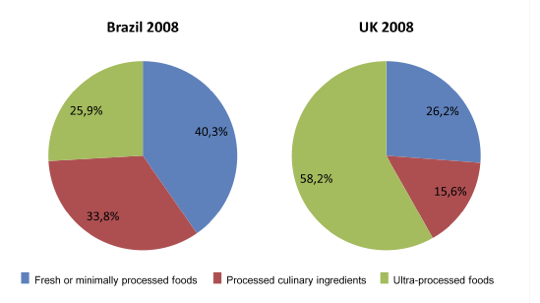
Estimates made from Pesquisa de Orçamentos Familiares for Brazil and from the 2008 Living Costs and Food Survey for UK.
These findings can be expressed in other ways. Thus, household consumption of ultra-processed products in the UK is considerably more than twice the amount consumed in Brazil. Also, the analysis indicates that most household dietary energy in Brazil comes from meals prepared at home, whereas most household dietary energy in the UK comes from ready-to-eat or ready-to-heat products.
Analysis of the specific foods, ingredients and products in the two 'food baskets' shows that in the UK, six of the ten items most consumed were ultra-processed products. These are first, sweet snacks (including cakes, pastries, biscuits, chocolate, confectionery), and then in descending order bread, take-away dishes, ready-to-eat breakfast cereals, processed meat, and soft drinks. These six types of product together made up almost half (48.2 per cent) of all dietary energy consumed in UK households. By contrast, in Brazilian households seven of the ten items most consumed were either fresh or minimally processed foods – rice, meat, beans, milk – or culinary ingredients – sugar (for use in cooking and at table), vegetable oils, and manioc (cassava) flour.
Box 2
Traditional diets: My view
Traditional meals are part of traditional diets or cuisines. Traditional diets characteristically have a culinary, nutritional and practical rationale, developed over centuries of discovery and experiment. They make the best of available foods. For example, traditional diets of people who live close to seas and rivers, as in Japan and Greece, include a lot of fish and seafood, whereas the diets of people who live inland include animal food or, when this is scarce, a combination of legumes (such as beans) and grains (such as rice).
It does not follow that traditional diets are ideal. The traditional Brazilian diet is a case in point. It is salty. This reflects the influence of the Portuguese cuisine, that of a maritime nation reliant on salted fish and other products preserved by salting. In Brazil, foods prepared at home typically contain a lot of salt added in cooking or at table. Correspondingly, rates of hypertension and stroke remain relatively high. Because Brazil is a sugar-producing nation, consumption of table sugar, used to make cakes, desserts and other foods at home, is also high. Additionally, despite the vast variety of native and established tropical fruits, average consumption of fruits in Brazil is about the same as that in the UK and Northern Europe. Nevertheless, in Brazil traditional minimally processed foods and culinary ingredients are overall less energy-dense, and contain less sugar, less sodium, less saturated fat and more dietary fibre, than ultra-processed products (3).
Programmes whose purpose is to improve the quality of national food supplies and diets, and thus prevent disease and improve health and well-being, are more likely to succeed when they seek to modify familiar traditional diets. When traditional diets disappear, as they have in many high-income countries, in practice the choices – when people can afford them – are between one type of ultra-processed product and another. Hence the vast number of branded products making health claims. In principle anybody – or anybody with the money – can construct an extremely healthy diet from what is available in supermarkets. But, as the rates of obesity in countries like the US and UK show, in practice this is not what is happening.
This is why preservation and protection – and improvement – of traditional diets, where these survive, as they do in Brazil, must be a crucial and central public health strategy, needing energetic and sustained support from government. Such policies will also protect local producers and support rural employment.
What does this indicate now and for the future? With my colleagues I am examining the relative prices of the different groups in different countries. A preliminary analysis shows that the combination of type 1 foods with type 2 ingredients as purchased in Brazil is currently a lot cheaper than type 3 products – types 1 and 2 combined are around 60 per cent of the cost of type 3 products. In the UK the story is different. There, the combination of type 1 foods with type 2 ingredients is slightly more expensive than type 3 products.
We think this is highly significant. Currently in Brazil, the price differential between types 1+2, and type 3, continues to encourage customers to buy items for preparation and cooking at home. In this way, families and households will retain traditional Brazilian meals. This includes those affordable by families with only small amounts of disposable income, of which the staples are rice, beans and cassava (manioc) flour, with relatively small amounts of meat. As long as Brazilian traditions survive, families with greater amounts of disposable income where meals are still prepared or cooked at home, can enjoy a greater variety of foods, with more vegetables, fruits, meat, and fish. (See the recipe for the 'classic' traditional moqueca fish stew, shown in Box 3).
Box 3
A traditional Brazilian meal
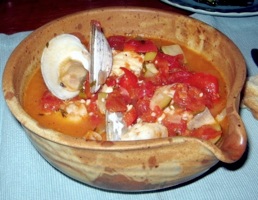
Meals are nourishing in a broad sense, because of being shared at the family table and with friends. Traditional Brazilian meals are not all about rice and beans. Traditional cuisines include a vast variety of 'classic' meat or fish stews made also with plenty of vegetables and herbs. In Brazil those made with fish are called moqueca (see the picture above). The version that comes from the state of Bahia, whose culture is strongly African, uses oil from the dende palm, intensely rich in vitamin A and very aromatic. Moqueca needs fresh fish and other ingredients, preferably purchased in markets, and a thick clay pot with a lid that retains heat, in which the dish is cooked and served. There is no one moqueca, and the recipe below for 6 to 8 people is a basis for experimentation. Use plenty of herbs and oil. The ingredients and their proportions can be varied.
Ingredients
1 kilogram of fresh sea or river fish
1 kilogram of shrimps or clams (or else more fish)
Spring onions, bell peppers, red onions, limes, tomatoes (plenty)
Coriander (lots), garlic (a whole bulb), salt
Olive oil, coconut milk, dende (see picture below, left) oil
Urucum (see picture below, right) powder (optional)
Cassava (manioc) flour (for the pirão sauce).
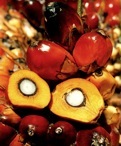

Method
Prepare and chop the vegetables, fruit and herbs.
Clean and cut the fish into chunky strips.
Heat the pot over a low flame.
Add the vegetables, fruit and herbs, with olive oil.
Squeeze lime juice over the fish, season, and place over the herbs.
Add coconut milk, and plenty of dende oil.
Put the pot lid on and cook for 15-20 minutes.
Serve in the pot at table, with boiled rice, and with pirão, a thick sauce made by
mixing the juices of the fish with cassava (manioc) flour.
Comments
The African influence is the coconut milk and the dende oil. A fish stew made using other oils is a different dish. See the recipe for Moqueca Capixaba in the June column on the Association's website by Fabio Gomes, for a version not using coconut milk or dende. Urucum (English name annatto) is a red fruit native to Brazil, used as
a spice and a dye, believed to have potent medicinal and healing qualities.
But powerful forces are combining to displace traditional meals prepared and cooked at home, with ultra-processed ready-to-heat and ready-to-eat pre-prepared dishes and snacks. That's where the big profits are. The strategy of the transnational and other manufacturers is to displace traditional regional and national food systems with their branded products. They aim to 'teach the world to snack' (6).
In Brazil and no doubt other lower-income other countries, currently ultra-processed products are more expensive than traditional staple foods and ingredients. This is liable to change, for a number of reasons. First, the costs of staple foods and ingredients are rocketing, and have more than doubled since 2007, two reasons being market manipulation and stock market speculation (7). Second, at any point transnational and other large manufacturers can lower the prices of key products to make them cheaper (or less expensive) and thus undercut staple traditional foods and ingredients. This strategy may continue until market research shows that a large proportion of customers have switched to their products. Third, manufacturers are making big investments in new factories in lower-income countries, taking over national and local companies, or undercutting them and so driving them out of business or else to cheapen their products.
As well as all this, transnational manufacturers have vast advertising and marketing budgets, which are used to persuade customers that their products are superior, healthier, and part of modern ways of life, whereas traditional foods and ingredients are supported by public bodies with relatively pitiful budgets. Further, transnational corporations are now energetically forming 'private-public partnerships' with governments, their agencies, and professional organisations, with financial, administrative, and other support. Also, manufacturers now are pushing many ultra-processed products as especially healthy, by adding synthetic micronutrients that enable them to make health claims. (I say more about this next month).
National governments especially in lower-income countries, where traditional food systems survive, need to be very sure of their value, in order to protect these systems from obliteration. This requires support from ministries of health, and also those of agriculture, education, employment, urban and rural development, environment, and others. This can happen if and only if informed and sustained pressure is applied by relevant professional bodies and civil society organisations.
Meals: the US gets the message
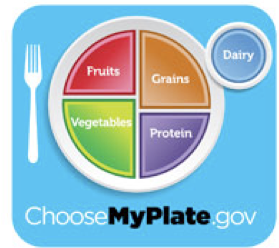
On 2 June, as this commentary was being prepared, the US Department of Agriculture issued a new graphic device designed as a guide to healthy food. This displaced the abstract 'food guide pyramid', used since 1992 (see box 4, below), with a symbol designed to look like a plate. Here it is, above. The accompanying text includes 'make half your plate fruits and vegetables, make at least half your grains whole grains' and 'drink water instead of sugary drinks'. Marion Nestle, an authority on food guides, comments: 'I don't think it goes far enough, but it's certainly headed in the right direction. This is a huge change, and I think it's courageous'.
Importantly, 'my plate', unlike the pyramid (and unlike the wheels and lists used previously; see Box 4) does associate nutrition with food. Like all graphic guides to food and nutrition, it has limitations. The items named, don't look like a meal. Fruits are not eaten with vegetables, and 'protein', shorthand for many foods containing substantial amounts of protein, looks odd. Also, relevant to this series of commentaries, there is little grasp of the significance of processing, except in that the guide recommends whole grains. Further, it gives only a slight sense of food preparation and cooking, and it doesn't adapt for countries where meals are eaten from separate bowls. But it is a dramatic change from the previous guides, in which meat, milk and dairy produce were grossly over-emphasised.
Box 4
US food guides 1940s-2011
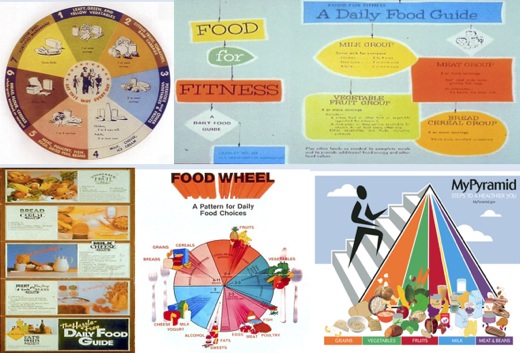
The US 'my plate' guide is the latest in a line of graphic symbols issued by the US Department of Agriculture as guides to a healthy diet. The wheel (top left), launched in the 1940s, featured 'the basic seven'. These were 1, leafy, green and yellow vegetables; 2, citrus fruit, tomatoes, raw cabbage; 3, potatoes and other vegetables and fruits; 4, milk, cheese, ice-cream; 5, meat, poultry, fish, eggs, dried peas, beans; 6, bread, cereals; and 7, butter and fortified margarine. As from the 1950s to the 1970s (top right) this was stripped down to the 'basic four' groups headed by milk, meat, then vegetables and fruit, and bread and cereals. This was followed by 'the hassle-free food guide' (bottom left) which added cheese as a headliner with milk, and added a fifth group of 'fats and sweets'.
The 'food wheel' of the 1980s (bottom, middle) in effect went back to seven groups, by separating vegetables and fruits, and admitting alcohol, and also attempted to give a sense of relative proportions by using different size segments. This was the precursor to the 'food guide pyramid', introduced in 1992, which survived in various versions until June 2011. Earlier versions of the pyramid are shown in the news item published in the June issue of the Association's website. A later version, first issued in 2005, is shown here (bottom right). This more or less obliterated the sense of relativities as between different food groups, and also emphasised physical activity with its 'stick man pyramid runner'.
Older customers in the US will have lived with many or even all of these guides. They have points in common. They all gave emphasis to meat and dairy products, commonly thought to reflect the USDA responsibilities to the meat and dairy industries. They also make little distinction between fresh and minimally processed foods and ultra-processed products. The graphics all fractionate foods and give no impression that foods are best consumed in the form of meals.
Implications
A thesis of this and other commentaries and papers (1-3, 6), is that the main single force driving the pandemic of obesity and sharp rises in the rates of various diseases related to obesity, is food supplies and therefore diets increasingly and eventually largely made up from ultra-processed products.
The more energy-dense any national or personal diet is, and the more available, convenient, cheap, the more it will induce obesity. This is all the more so when diets are largely made up from ultra-processed products formulated to be intensely palatable and even practically addictive by use of chemical additives and other ingredients and additives, and that are available in all types of outlet that sell food, packaged so that they can be consumed anywhere, and aggressively marketed.
The food supplies of the US, the UK and some other high-income countries may now be saturated with ultra-processed products. If so, the current rates of obesity in these countries, currently among the highest in the world, may well not greatly increase. Study of annual reports and the business press, shows that the main targets for 'double digit' (10 per cent or more) annual depth of market penetration by transnational corporations are Asia, the Middle East, Latin America, and Africa.
These corporations, also known as 'Big Snack'(6) are powerful. They have pushed for the current vogue for 'public-private partnerships' whose agenda is largely controlled by industry. Governments remain reluctant to impose statutory regulations. Given this, and the thesis of these commentaries, it follows that perhaps within a generation or two, rates of obesity in all but the most impoverished countries in the world will approximate to or even exceed current rates in the USA and UK. This is already the case in Mexico (8). In Brazil, where prevalence of overweight or obese adults is increasing by 1 percentage point a year, rates similar to the US and UK are projected to be reached around or just after 2020 (9).
As part of such a process, rates of diabetes and heart disease in populations sensitive to these diseases will continue to increase explosively, and rates of colorectal, breast, and other major cancers will also sharply increase. Few if any countries have or would have the resources to treat such epidemic diseases on a population basis. Only relatively rich people can afford treatment. In high-income countries, current epidemic chronic diseases are a burden. Equivalent rates of obesity and chronic diseases in lower-income countries, many of which still suffer high rates of malnutrition and infectious diseases, would be a catastrophe, liable to destroy their social, cultural, economic and other fabric, and in the worst cases turning them into 'failed states'.
The most effective counter to such a threat is in terms not of nutrients or foods, so much as meals. The national and local governments of all countries and regions that still retain traditional and established food systems, expressed in terms of meals, need to know that the preservation and protection of these systems is crucial, for public health, and also for national and local independence, viability and identity.
The necessary commitment can take different forms. Protection of traditional cuisines implies support of co-operative and family producers of primary products, and thus of rural livelihoods. In turn this implies environmental protection. As another example, this implies improved prospects for tourism. Some tourists may prefer to consume burgers. But memorable vacations in new countries include the adventure of enjoying the meals of that country, whose traditional cuisines therefore need to be preserved even if only to gain foreign exchange.
A task, not so much for more research as more thought, is to compile all the reasons why meals and traditional diets and cuisines must be preserved and protected. The findings should then be made known to all relevant governments and other policy-makers.
References
- Monteiro C. The big issue is ultra-processing. World Nutrition November 2010, 1, 6: 237-259. Obtainable at: www.wphna.org.
- Monteiro C, Levy R, Claro R, Castro I, Cannon G. A new classification of foods based on the extent and purpose of their processing. Cadernos de Saúde Pública 2010; 26, 11: 2039-2049.
- Monteiro C, Levy R, Claro R, Castro I, Cannon G. Increasing consumption of ultra-processed foods and likely impact on public health: evidence from Brazil. Public Health Nutrition 2011; 14, 1: 5-13.
- The Giessen Declaration. Public Health Nutrition 2005; 6(A): 783-786.
- Monteiro C. The big issue is ultra-processing. In praise of the shared meal. [Commentary] World Nutrition, May 2011, 2, 5: 235-246.
- Monteiro CA, Gomes FS, Cannon G. The snack attack. American Journal of Public Health 2010, 100: 975-981.
- Schuftan C. Food price crises: 'Free markets' cause inequity and hunger. [Commentary] World Nutrition June 2011, 2, 6: 254-270.
- Barquera S, Campos-Nonato I, Hernández-Barrera L, Flores M, Durazo-Arvizu R, Kanter R, Rivera JA. Obesity and central adiposity in Mexican adults: results from the Mexican National Health and Nutrition Survey 2006. Salud Pública de México 2009, 51: s595-s603.
- Ministério da Saúde. Vigitel Brasil 2010. http://portal.saude.gov.br/portal/ arquivos/pdf/vigitel_2010_preliminar_web.pdf.
Acknowledgement and request
Readers are invited please to respond. Please use the response facility below. Readers may make use of the material in this editorial if acknowledgement is given to the Association, and WN is cited
Please cite as: Monteiro C. The big issue is ultra-processing. The price and value of meals. [Commentary] World Nutrition, June 2011, 2, 6: 271-282. Obtainable at www.wphna.org
The opinions expressed in all contributions to the website of the World Public Health Nutrition Association (the Association) including its journal World Nutrition, are those of their authors. They should not be taken to be the view or policy of the Association, or of any of its affiliated or associated bodies, unless this is explicitly stated.
CAM states: Geoffrey Cannon has worked with me on all these commentaries and I regard him as my co-author. The analysis and calculations comparing the UK and Brazil included here were done by Rafael Claro and Renata Bertazzi-Levy. All the commentaries have benefited from discussions I have had in the last two years or so with Inês Castro, Renata Bertazzi-Levy, and Rafael Claro, and also with Geoffrey Cannon and Fabio Gomes, who are all co-authors with me of other papers, published (2, 3, 6) and in preparation. I have no conflicts of interest.
WN commentaries are subject to internal review by members of the editorial team.






